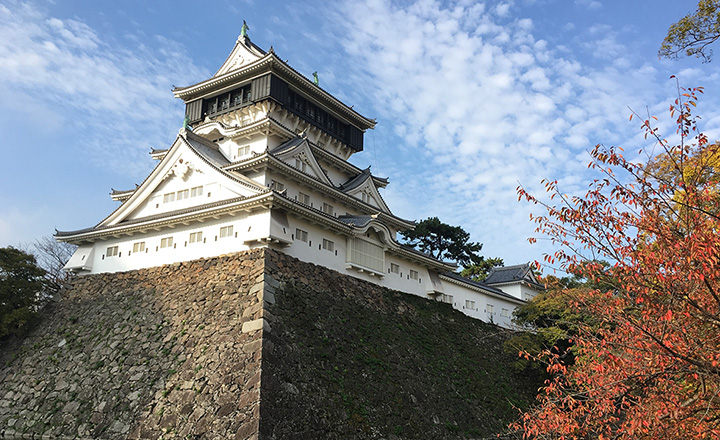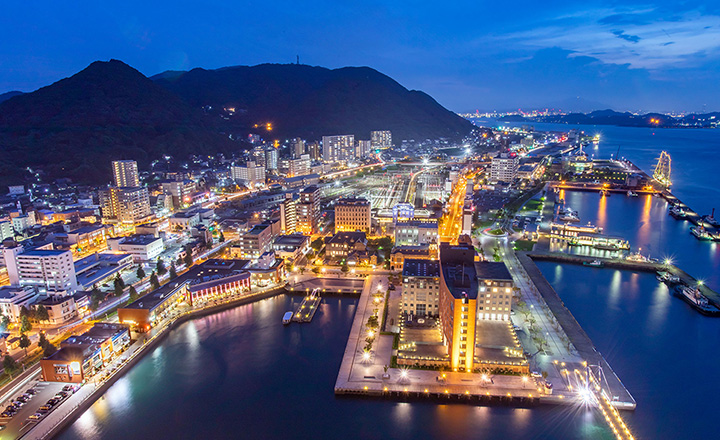ABOUTProject Overview
<2020 Host City>
City of Kitakyushu,JAPAN
The City of Kitakyushu was created through an equal merger among 5 cities in 1963 as the first ordinance-designated city in Kyushu. Situated at the gateway to Kyushu, it sits adjacent to Honshu with the Kanmon Strait in between and has developed as a key point for land and sea transport since long ago because of its geographic proximity to the continent.
In addition, the city has grown around the heavy chemical industry that includes iron/steel, machinery, and chemicals since the government-owned Yawata Steel Works began operating in 1901, underpinning Japan’s industrial modernization and high economic growth. As a result of an influx of people and information from within Japan and abroad, the city has also prospered as a culturally advanced area that mingles with local culture, and has demonstrated the spread of cultural activities centering on companies unique to a concentration of companies that included Yawata Steel Works. This had a significant influence on the promotion of culture and art in the City of Kitakyushu. Recently, numerous industries such as the robotics, automotive, telecommunications, and service industries have assembled in the city, which today is developing as a City of Manufacturing that boasts advanced technical prowess.
On the other hand, through collaboration among residents, companies and the government the city has conquered the tribulations of pollution caused by the rapid industrial development process. Since the 1980s, there has been a shift to focus on policies for creating a pleasant urban environment, and the City of Kitakyushu has achieved inter-urban collaboration and exchange, and international cooperation on environmental technologies not only within Japan but also with other cities in Asia. In recognition of such endeavors, it was chosen as a Green Growth City by the Organization for Economic Cooperation and Development (OECD) in 2011. Furthermore, in 2018 it was the only city in Asia to become the SDGs Model City of OECD. This global appreciation of comprehensive “sustainable city development” goes beyond the sphere of environmental conservation.
Furthermore, the recent transition in industrial structure has led to the scaling down of the industrial area centering on Yawata Steel Works, prompting the city to move forward with new urban planning that includes clusters of cultural facilities such as museums and development of commercial facilities. The city will utilize this group of cultural facilities to hold an art festival based on the theme of SDGs indispensable to building a better world.
By hosting the “Culture City of East Asia in Kitakyushu,” the City of Kitakyushu aims to contribute to friendly development and further deepen mutual understanding within East Asia. At the same time, it is striving to realize Creative City: Kitakyushu, which promotes creative urban development using the power of culture and art.


City of Yangzhou,CHINA
Yangzhou is located in central Jiangsu Province where the Yangtze River and Grand Canal meet. It has a 6,000-year history of civilization and a history of established walled cities spanning over 2,500 years. It is among the first Historic and Cultural Cities in China proclaimed by the State Council, is a United Nations Human Settlements Program (UN-Habitat) city, and the first excellent tourism city in China. On August 30, 2019, Yangzhou was chosen as a Culture City of East Asia 2020.
Yangzhou is an historical and cultural city with a well-preserved atmosphere of an ancient walled city. The 5.09 sq. km. historic urban area has an ancient fortress over a thousand years old that is relatively well preserved by the Chinese government. Dongguan Street in the old town area was named one of the 10 famous historically and culturally valuable streets by the National Ministry of Culture in 2010.
Yangzhou is the only canal city in China. Since King Fuchai of Wu broke ground on the Grand Canal 2,500 years ago in Yangzhou, it has become the only city in China to grow along with China’s ancient canal. The city already has developed water tourism due to the ancient canal and has become the top choice for many tourists from China and abroad for attractions that include historical and cultural remnants such as the ruins of the south gate on the coast, Kangshan Park, Lu’s Salt Merchant House, Wu Dao Tai’s Residence, Dongguan Gudu ferry, and a canal on par with the Great Wall in Beijing.
Yangzhou is an exquisite, beautiful garden city. The top-rated 5A tourist area, Shugang-Slender West Lake Scenic Spot is currently China’s only “national tourism demonstration area.” Geyuan Garden (private garden) is one of the best four gardens in China and is representative of the city’s gardens. A part of the corridor of He Garden, which is the most famous garden from the late Qing Dynasty, is a divided two-story corridor and has an exquisite bridge. In addition, there are numerous salt merchant homes, such as Wang’s Residence, Lu’s salt Merchant House, Wang Lumen’s Residence, and Pangu Garden. Visitors can see the essence of the salt merchant culture everywhere.
Yangzhou is the birthplace of Huaiyang cuisine, which is one of the four great traditions in Chinese cuisine. The globally famous Yangzhou fried rice originated in this city. The typical, casual lifestyle of people from Yangzhou is expressed by the saying “to have tea in the morning and a bath in the evening,” referring to its breakfast culture that is only matched by its bathhouses visited in the evenings. This kind of lifestyle of dim sum and tea in the mornings and baths in the evenings is an envious way of life for modern-day city dwellers. The emergence of a series of high-class leisure tours including sites such as Yangzhou Center and Residence, Slender West Lake Hot Spring Resort Yangzhou, golf courses, and the 1912 Block in Yangzhou heightens the appeal of spending leisurely holidays in the city. Yangzhou has twice been chosen one of the top 10 leisure cities in China.
Yangzhou is a garden city alive with sweet-smelling fragrances. At Shugang-Slender West Lake Scenic Spot, a flower festival is held every year during which various fragrances fill the air. Marco Polo Flower World is a theme park featuring an endless exhibit of flowers. Visitors become fully immersed in the dramatic travels of Marco Polo in the world’s largest flower park that boasts a carpet of artistically arranged flowers covering the longest area in China. There are 5 areas including fantastic hills of flowers designed by Dutch landscape artists and garden plants inspired by an Oscar-winning animation team.
Yangzhou not only has excellent natural landscapes, but also unique garden sites, outstanding culture and art, and beautifully presented cuisine. Everything to see and hear is brilliant in this energetic city that has much to offer, such as the beauty and elegance of an ancient walled city.


City of Suncheon,KOREA
Suncheon is a small city of 280,000 people located in the eastern area of South Jeolla Province in the Republic of Korea. It is a remarkable city that excels in a variety of areas.
Suncheon is an educational city.
he city produces numerous outstanding human resources and is striving to build a foundation to become a sustainable education city. In addition to being designated a Lifelong Learning City in 2003, it was chosen as the location of the 2020 Republic of Korea Lifelong Learning Expo.
Suncheon is a cultural city.
Not only does the city have various historical and cultural resources such as Seonamsa Temple which is a registered UNESCO World Heritage Site, Naganeupseong Town Fortress which is registered on the World Heritage Tentative List, and Songgwangsa Temple, but it also has all types of cultural properties. In addition, along with international cultural festivals including Suncheon Bay International Orchestra Festival and Suncheon Bay World Animal Film Festival, culture and arts such as outdoor performances flourish in Suncheon throughout the city center.
Suncheon is an Eco City.
The city is home to Suncheon Bay Garden, which was designated as the Republic of Korea’s first national garden, and was accredited a Wetland City by the Ramsar Convention. It is also home to the Suncheon Bay Tidal Flats that are to be registered as a UNESCO World Natural Heritage site in 2020. Furthermore, the entire city is registered as a UNESCO Biosphere Reserve. Suncheon has been established as an Eco City both in name and reality within and without Korea. It is visited by more than 1,000 hooded cranes, which are symbols of peace and good fortune.
Suncheon is a city preparing for the future.
The city is making the most of its unique strengths in education and ecology to create a 4th industrial revolution cluster for the purpose of cultivating new growth industries to address the age of the 4th industrial revolution, and to promote innovative strategies in areas such as AR/VR and e-sports to specialize/develop the regional economy. Through these endeavors, Suncheon is striving to move forward as a city of ecology and economy that leads not only the Republic of Korea, but also the world.

